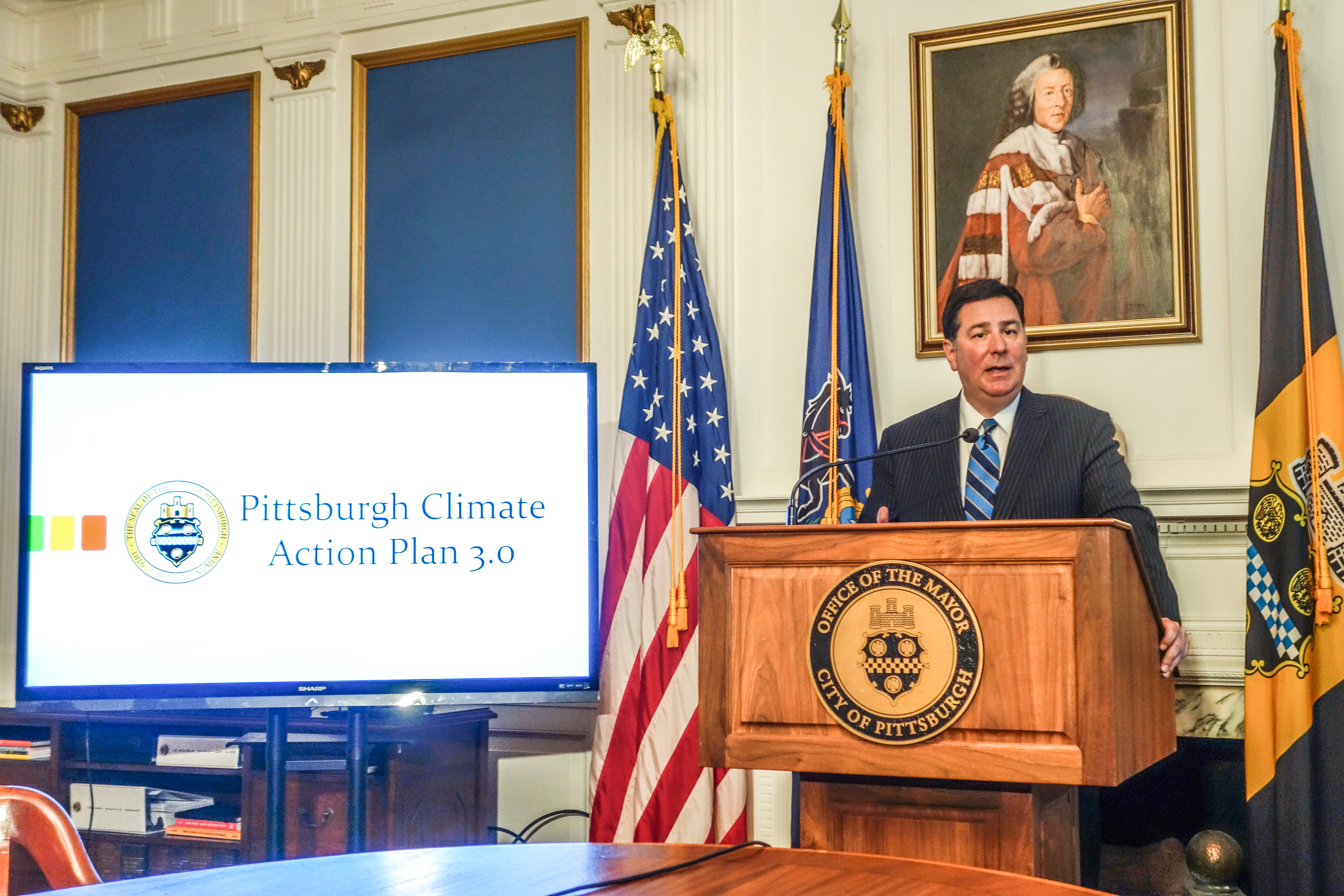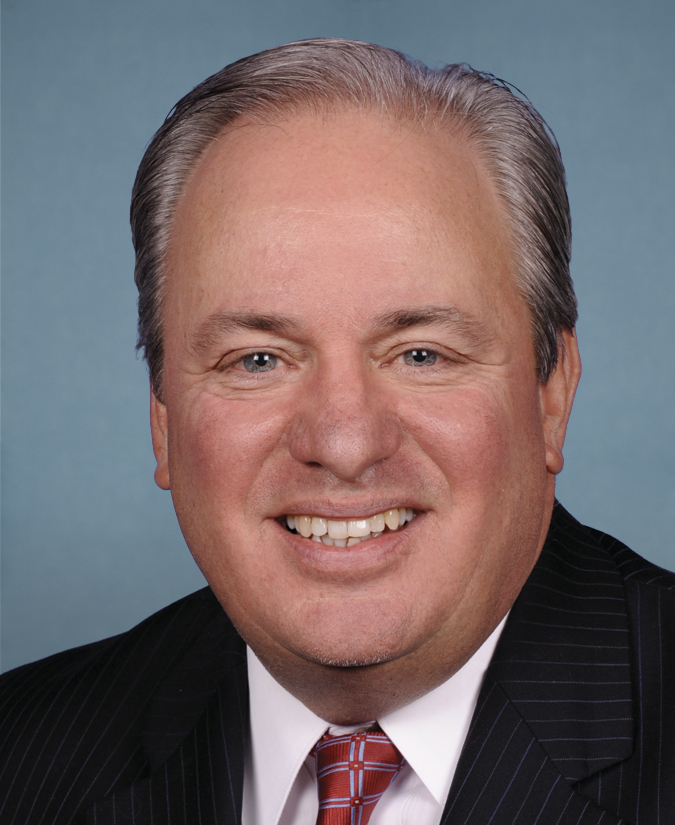
(Photo illustration by Idil Gozde/PublicSource)

(Photo illustration by Idil Gozde/PublicSource)
It was an unusual scene: environmentalists of every stripe praised the city of Pittsburgh for creating a plan that finally laid out just how serious Pittsburgh needed to get about climate change. And yet many of them didn’t seem convinced it would work.
“We don’t see this actually as a plan,” said Jason Beery of the UrbanKind Institute. “This is currently a list of goals and a survey of possible actions.”
About 75 people showed up to Pittsburgh’s council chambers on Nov. 29 to comment on the city’s ambitious new climate action plan, which lays out its strategy to cut greenhouse gas emissions in the city 50 percent by 2030 and 80 percent by 2050. The plan includes many changes, from cutting the city’s meat consumption in half to planting 780,000 trees, which could transform life in the city, including where Pittsburghers live and how they get to work.
Lindsay Baxter, who played an instrumental role in writing the city’s first two plans as the former sustainability coordinator, urged the city to spell out which of its ideas would have the most impact. “The urgency of climate change necessitates a plan that leads to action rather than one that establishes a vision alone,” she said.
The city’s plan relies on individuals and businesses to make big changes. But if it isn’t clear in its 100-page plan what should be prioritized, how will Pittsburghers know how to rally behind it?

Robert Akscyn criticized the city's new climate action plan at a December city council hearing. (Photo by Oliver Morrison/PublicSource)
Of all the people who showed up, only one, Robert Akscyn, opposed the plan. As he rose to speak, the room got quiet.
“Goals without plans are dreams. And plans without resources are delusions,” Akscyn said. “So if I were Pittsburgh...I would have a full-time staff of something like 50 to 100 people, volunteers and full timers in a NASA-like mission control context...because the scale of the problem deserves something of that approach.”
A number of people started snapping their fingers in support: The only person opposed thought the city’s grand plan wasn’t grand enough.
Mayor Bill Peduto still has a tweet from June 1 pinned to the top of his Twitter page: “As the Mayor of Pittsburgh, I can assure you that we will follow the guidelines of the Paris Agreement for our people, our economy & future.”
He was responding to comments by President Donald Trump, who plans to pull the country out of the Paris Agreement on climate change. Trump said he was “elected by voters of Pittsburgh, not Paris.”
The prominence the mayor has given to the city’s efforts to combat climate change has raised the stakes.

Mayor Bill Peduto answers questions at a press conference about the city's proposed climate action plan, which was released in September 2017. (Photo by Oliver Morrison/PublicSource)
And because of inaction at the federal level, many are now looking at cities like Pittsburgh to pick up the slack. In the United States, cities are the source of most emissions. They also tend to have more money and political support to implement changes.
But even the Pittsburgh climate plan’s biggest supporters are skeptical. They say that it has a lot of good ideas — e.g. increase biking and buy green energy — but doesn’t say which of those ideas are most important or what order to implement them in. Along with that, the plan doesn’t clarify how much each will cost.
Adding to the skepticism is the city’s record so far: The city’s first two climate plans helped lay the groundwork for some of the city’s most innovative climate initiatives, like the fact that it even has a position focused on environmental sustainability.
The plan led to the widespread replacement of old light bulbs with LED bulbs and the 2030 district — a coalition in Downtown and Oakland focused on meeting the 50 percent reduction targets. Yet, despite the efforts, overall emissions have increased since the city started measuring it in 2003, rather than decreased, according to its most recent data.
The city needs a more specific plan, Nicki Aviel, a senior at the University of Pittsburgh, told the city council, “so we accomplish more than a fraction of the goals like we did with the previous plans.”
The city doesn’t have additional money to implement its climate plan, according to Grant Ervin, the city’s chief resilience officer. The budget is the city’s normal capital budget.

Grant Ervin, Pittsburgh's chief resilience officer, is leading the city's new plan to address climate change. (Photo by Justin Merriman/PublicSource)
So as the city invests in new cars and energy sources, it will start using its ordinary budget in more climate-friendly ways. And he said he expects in many cases, these changes will either pay for themselves or save money in the long run.
The same is true for the city’s businesses and people, he said. “You are making utility decisions. You are making home improvement decisions. You are buying appliances…” he said. “So that’s the [climate plan] budget.”
But the method that most economists think would allow U.S. cities like Pittsburgh the best chance of success — putting a price on carbon — is no longer on the table. And in its absence, Pittsburgh's environmentalists are confused about what exactly the city is proposing should take its place.
To understand why we’re at this point we need to look back to 2009, when U.S. Rep. Mike Doyle was whipping up votes in Congress for the American Clean Energy and Security Act.
“I think we’re so close now, and there’s so many undecideds leaning ‘yes,’ that there’s a sense once you put it on the floor, they’re going to vote with us,” Doyle, D-Pa., told a reporter at the time.

U.S. Rep. Mike Doyle, D-Pa. (Courtesy photo)
Doyle and his colleagues never did round up enough votes. Their attention turned toward passing healthcare legislation and then the balance of power in Congress and then the presidency, as it all shifted toward the Republicans.
During a recent visit to Doyle's office on the South Side, the first two words out of his mouth about what help Pittsburgh could expect from Congress, were, “Not much.”
Part of the reason Democrats are being cautious about pushing a climate plan, he said, was the lesson they learned in 2009 on health care. When Democrats passed the Affordable Care Act, they changed the way pre-existing conditions in health care were treated for good. But they also paid a big political price for moving so quickly, he said.
“Big ships turn slowly,” he said. “And when you are trying to turn a big ship that is health care, that is energy, things like that, you have to get public buy-in. If you don’t have it, then you lose 51 seats.”
One of the core ideas of the failed energy bill was an idea, which was long considered conservative: the best way to fight climate change is to allow the free market to work its magic. The government would issue permits to emit a certain amount of greenhouse gases and then companies could buy and sell them in the marketplace.
Companies that could produce power and products cleanly could sell their permits to industries, like coal power plants, which tended to emit more. This would make coal power more expensive, but also reward those coal plants that could generate the same electricity with less emissions. Businesses would make more money by being more green.
And the idea is that ordinary people would benefit from the transparency. Most people don’t know the hidden environmental costs of each product they buy. But with a carbon tax, the price of beef, which creates a lot of greenhouse gas emissions, would increase by more than the price of chicken and far exceed the increased cost of a carrot. So people would likely buy more carrots and chicken and less beef, and emissions would go down.
Ervin, whose office put together the new climate plan, agrees with the economists. “But in the absence of putting a price on carbon… you have to find ways in which to develop a variety of arrows that you have in your quiver that you can use.”
Though Pittsburgh’s plan seems imperfect even to its supporters, it reflects the current approach taken in international climate talks. Instead of limiting how much each country can emit, each country decides on their own how much they will emit.
Michaël Aklin, who teaches political economy at the University of Pittsburgh, explains to his students the peculiar strategy that the world is depending on in this way: Imagine you have an exam and you get to write your own questions. You would expect the exam to be too easy and everyone to get an A.
“At first sight, that looks a little bit crazy,” he said. “…That doesn’t sound like it makes a lot of sense, but it can.”
In the lead-up to the most recent international climate talks in Bonn, Germany, no major industrialized country in the world was on track to meet its climate goals, according to The New York Times.
“It is, in effect, a giant bet on the power of peer pressure — with the future of the planet at stake,” the Times wrote. “And no one yet knows how that bet will pan out.”
The idea is that, at least by signing onto the agreement, each country will have to be transparent about how much they are emitting, Aklin said. And then, if the countries don’t make progress, voters can kick their leaders out of office.
One problem with previous plans — such as the Kyoto Protocol, which mandated emissions cutbacks — is that many countries didn’t like how it would affect their economies. So it didn’t get enough political support.
Instead, Aklin said, it can sometimes be more effective for politicians to spend money on a specific solution, such as green energy, rather than more sweeping but unpopular plans, such as a carbon tax.
“It’s easier to spend money on solutions,” he said. “If you spend money, [those industries] will be on your side after. But if you make gasoline expensive, you just annoy everybody.”

That’s why, he thinks, you see some of the biggest producers of green energy in conservative states like Texas and Kansas. The farmers who are being paid for generating wind energy on their land have become a loud voice in favor of renewable energy and the subsidies supporting it. And as long as the subsidies landowners receive don’t get too large, it doesn’t bother most taxpayers.
Some economists favor placing a tax on coal, he said, but that just makes the people who depend on coal for their livelihoods angry. “But if you just spend $1 billion more [on renewable energy], nobody will notice that,” Aklin said.
Pittsburgh’s plan reflects this sort of politically expedient calculus. It commits the city to buying 100 percent green energy by 2035 but doesn’t try to regulate coal, one of the biggest emitters. It plans for increasing its own fleet of electric vehicles but doesn’t have any mandates that might raise the cost of owning a car.
“You see often people say, ‘If only we implement a carbon tax then everything would be great,’” Aklin said. “Sure, but there are very few places where politicians can come up with a carbon tax and not feel the heat. So when we think of policies, rule out the ones that have no chance of happening. That tends to be a distraction.”
Nicholas Muller, an environmental economist at Carnegie Mellon University, said he thinks it’s politically courageous for the city to take on a plan where many of the benefits may not be felt for a long time and could be more appreciable in locations that are expected to experience the more severe effects of climate change, like Louisiana or Bangladesh.
The plan does what Muller thinks a plan should do, in the absence of a carbon price: Let individuals and organizations decide best how to reduce their emissions.
“They are going to know their processes better than a centralized decision-maker,” he said. “The role of the decision-maker is to set the broad goal.”
The University of Pittsburgh, for example, released new sustainability “goals and aspirations” in December that are directly aligned with the climate plan: a 50 percent increase in tree cover and a 25 percent decrease in food that comes from animals by 2025.
But if individuals and organizations are in the best position to make changes, how should they decide what to focus on?
Environmentalists often cite “The McKinsey curve,” a report that prioritizes the most cost-effective ways to tackle climate change. The idea is that if you have a limited amount of money, time and resources, which strategies should you do first?
The curve lays out how people can actually save money and be good for the environment: replacing inefficient refrigerators and HVAC systems are two of the best. Other changes, such as electric cars and solar energy generation, could have an even bigger potential impact but cost more.
Part of the city’s emphasis next year, Ervin said, will be getting out into the community to communicate more extensively what’s in the climate action plan and help educate people about these decisions.
But there isn’t a similar report and “McKinsey curve” for what cities should be doing first, Ervin said.
So when he hears people say there is not a clear cost tied to the city’s various strategies, he said, that’s partly the point. The next step for the city is going to be to try to figure out the costs.
“There is no prescriptive way in which to achieve these emission reductions,” he said. “There is not a book on the shelf that tells you how to do this.”
Story by Oliver Morrison
Fact-checked by Abigail Lind
Edited by Halle Stockton and Mila Sanina
Illustrations by Idil Gözde
Design and development by Natasha Khan
Have additional questions or thoughts about this story? Email Oliver at oliver@publicsource.org or find him on Twitter @ORMorrison.
Who in the Pittsburgh region is making a unique or admirable effort to reduce their carbon footprint? How does the concern over climate change shape their everyday behavior? PublicSource is looking for nominations for Pittsburgh’s Climate BFF.
We will interview the greenest and most interesting nominees and feature short profiles. Email reporter Oliver Morrison at oliver@publicsource.org or call him at 412-515-0063 to share who you are nominating (it can be you!) and why the person deserves to be Pittsburgh’s Climate BFF.